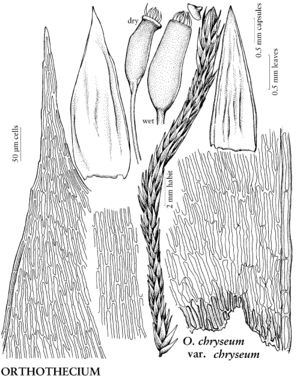Orthothecium
in P. Bruch and W. P. Schimper, Bryol. Europ. 5: 105, plates 460–463. 1851.
| Taxon | Illustrator ⠉ | |
|---|---|---|
 | Orthothecium chryseum | Patricia M. Eckel |
 | Orthothecium strictum | Patricia M. Eckel |
Plants very small to large, in loose to dense tufts or mats, green, yellowish, golden, reddish, or brownish, shiny. Stems erect to ascending, rarely creeping, not to sparsely branched; hyalodermis absent, central strand present; pseudoparaphyllia absent. Stem and branch leaves similar, erect to erect-spreading, lanceolate to ovate, usually widest at base, not to strongly plicate; base decurrent or not; margins incurved proximally, plane or recurved distally, entire or minutely serrulate at apex; apex acuminate; ecostate or costa short, double to mid leaf, one branch usually longer; alar cells not or poorly differentiated, rectangular; laminal cells smooth; distal cells usually longer than 6: 1. Specialized asexual reproduction very rare, by axillary propagula. Sexual condition dioicous; perichaetial leaves lanceolate, ovatelanceolate, or ovate-triangular, apex acuminate. Seta golden brown, purple, or reddish. Capsule erect, cylindric to subglobose, symmetric to slightly asymmetric, commonly flaring at mouth; annulus 2-seriate or 3-seriate, cell-walls ± thick; operculum conic; peristome double, attached at mouth; exostome teeth with external surface with zigzag center line, cross-striolate proximally, papillose distally; endostome basal membrane low to moderately high, segments as long as exostome to somewhat longer, broad to linear, keeled, cilia present or absent. Calyptra naked. Spores round, essentially smooth.
Distribution
North America, Europe, Asia, Africa
Discussion
Species 10 (5 in the flora).
Many authors (V. F. Brotherus 1907; E. Nyholm 1954–1969, no. 5; E. Lawton 1971; A. Noguchi and Z. Iwatsuki 1987+, part 5) have placed Orthothecium in Entodontaceae. However, W. R. Buck (1980) concluded that, based on leaves with a short, double costa, undifferentiated alar cells and a hypnoid peristome, Orthothecium should be placed in Hypnoideae of Hypnaceae. The genus is found in terrestrial, calcicolous habitats from near sea level to high elevations in temperate to boreal and Arctic regions. The straight to distinctly secund stem has small, very thin-walled epidermal cells in 3 or 4 rows surrounding larger, thinner-walled inner cells; the branches are radiculose at their bases. The leaves are more or less concave; the cells across the insertion are often dark and relatively short, with walls relatively thick and porose. The inflorescences are near the base of stems; the setae are twisted; the capsules have isodiametric or rounded exothecial cells, and few stomata at the extreme base of the urn; the exostome teeth are broadly lanceolate and pale yellow; and the endostome segments are perforate and usually papillose.
Selected References
None.
Lower Taxa
Key
| 1 | Leaves strongly plicate; stems 4-10 cm, 3 mm wide | > 2 |
| 1 | Leaves not or slightly plicate; stems 1-6 cm, 0.2-0.5 mm wide | > 3 |
| 2 | Plants golden; leaf apices short-acuminate; bases slightly decurrent; margins partially recurved. | Orthothecium chryseum |
| 2 | Plants reddish to brownish; leaf apices long-acuminate; bases not decurrent; margins plane. | Orthothecium rufescens |
| 3 | Leaves homomallous, narrowly lanceolate. | Orthothecium intricatum |
| 3 | Leaves straight, ovate to ovate-lanceolate | > 4 |
| 4 | Leaf margins partially recurved; leaves ovate-lanceolate; apices short, flexuose. | Orthothecium strictum |
| 4 | Leaf margins plane; leaves broadly ovate; apices abruptly short-acuminate to apiculate. | Orthothecium acuminatum |